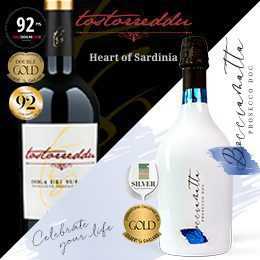Everyone knows that Italy is home to the oldest cities in the world: Rome, Naples, Matera, Palermo, Siracusa just to mention a few. Probably few people know that right in Italy was also built the first modern city of Europe: Ferrara.
Ferrara
Not so far from Bologna, traveling towards Venice, you will find the city of Ferrara, located in the Emilian plain a few kilometers south of the river Po’ and just 50 kilometers from the sea.
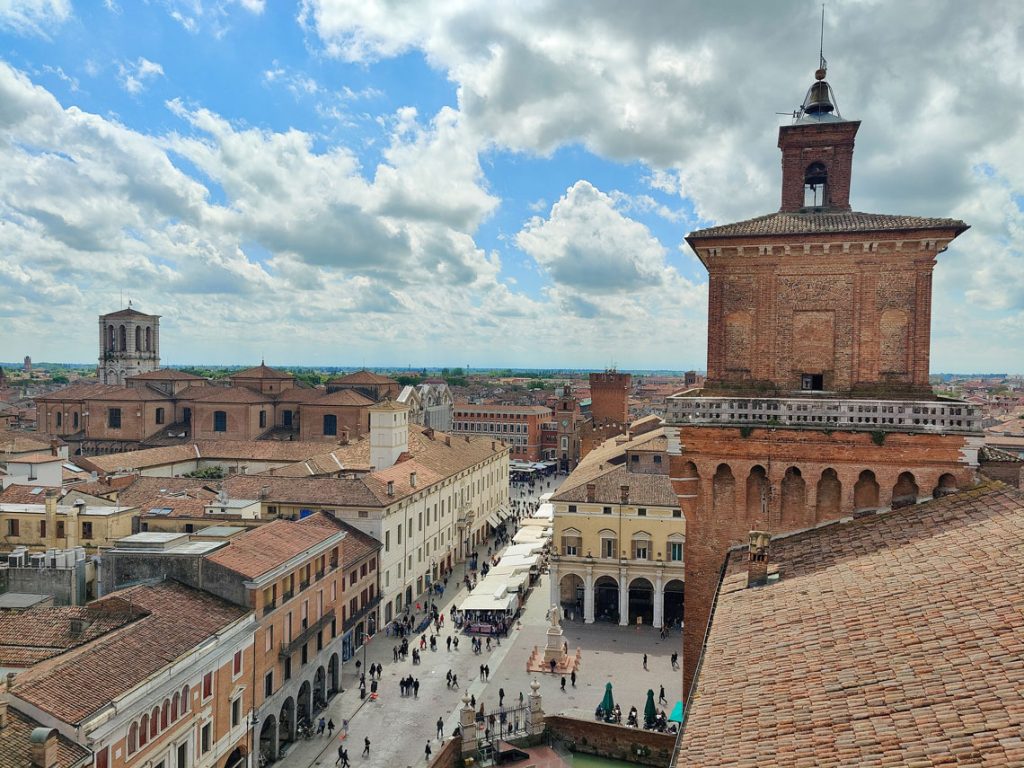
For its historic center, which remained intact over time, and where art and culture are breathed in every corner, in 1995 Ferrara obtained the recognition of World Heritage by UNESCO.
💡 Interesting to know
Why Ferrara is the first modern city of Europe? Right here during the Renaissance was realized one of the most important urban planning projects of modern European history called the Herculean Addition. It is the first example of reasoned planning of urban spaces, commissioned in 1484 by Duke Ercole I d’Este (Hercules, from which it takes its name) to the architect Biagio Rossetti. For the first time the project included straight and spacious streets, many squares, gardens and superb architecture and it was later taken as an example from all the cities of the world. Besides the Herculean Addition allowed the city of Ferrara to grow almost double inside the entire fortified wall.
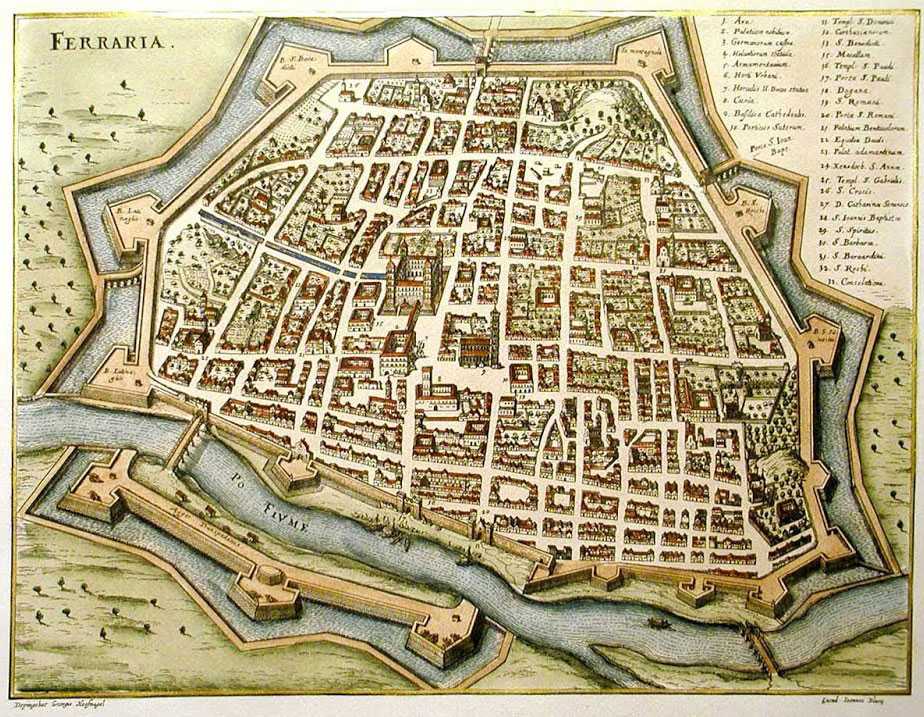
In just three centuries the dynasty of the Estense family, a large family of patrons, was able to transform a rural center in a masterpiece of the Renaissance.
The heart of the city is enclosed by 9 km of walls, developed primarily for defensive purposes. The walls of Ferrara along with the Tuscan town of Lucca, are among the most impressive and best preserved in Italy.
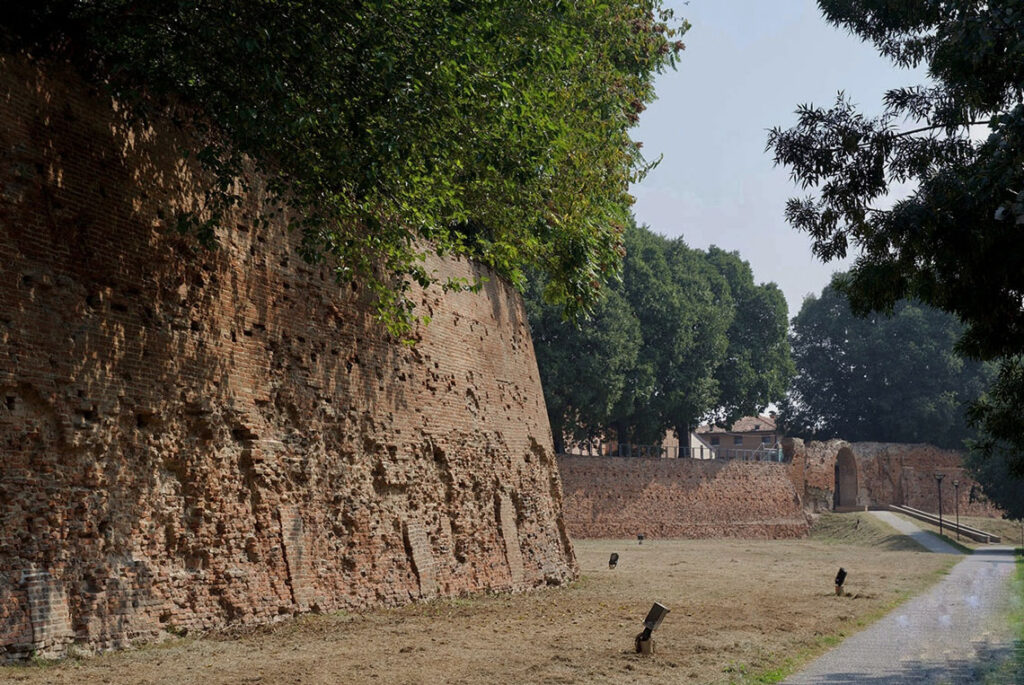
The first thing you perceive in Ferrara is the large number of bicycles in motion, the citizens’ favorite means of transport. With over 150 km of cycle paths both residents and tourists cycle through the streets and around the ancient city walls. The density of bike paths is among the highest in Italy and I personally have seen more bicycles here than in Amsterdam. That’s why Ferrara is also known as the Town of bicycles.
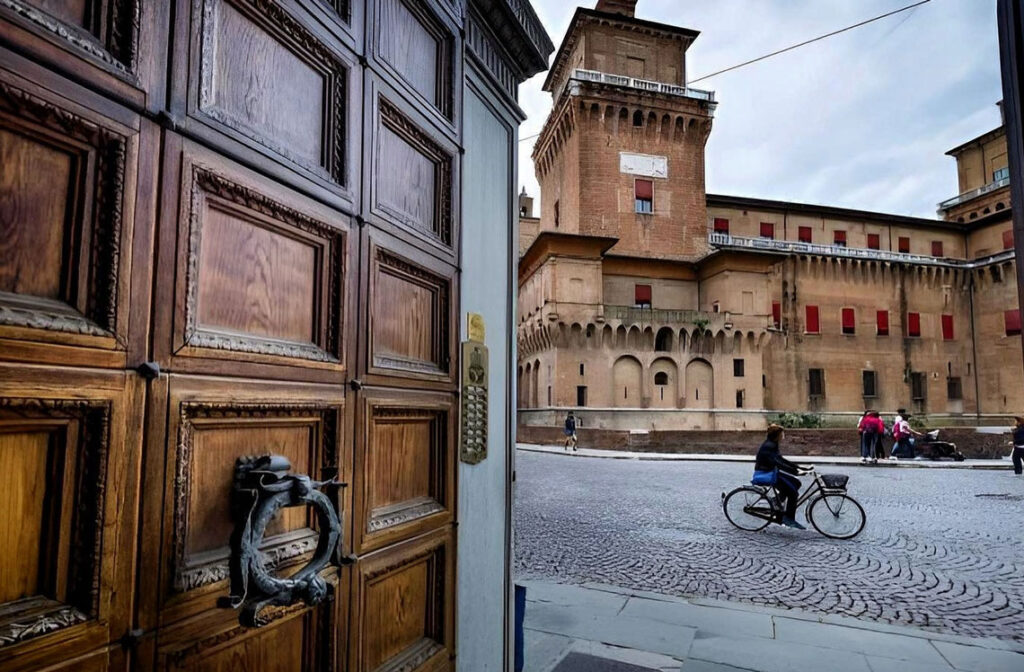
A day will be enough to see Ferrara just from “outside” but if you really want to experience the city with all its authenticity I would recommend to stay at least for a weekend.
If you come by car do not be anxious to look for a parking, just few meters from the center there is a huge one called EX MOF free.
What to see in Ferrara
Via delle Volte
My journey starts from the medieval heart of Ferrara – the narrow and cobbled street called Via delle Volte. The street takes its name from the many overhead passageways and numerous suspended vaults which cross it for its 2 km in length.
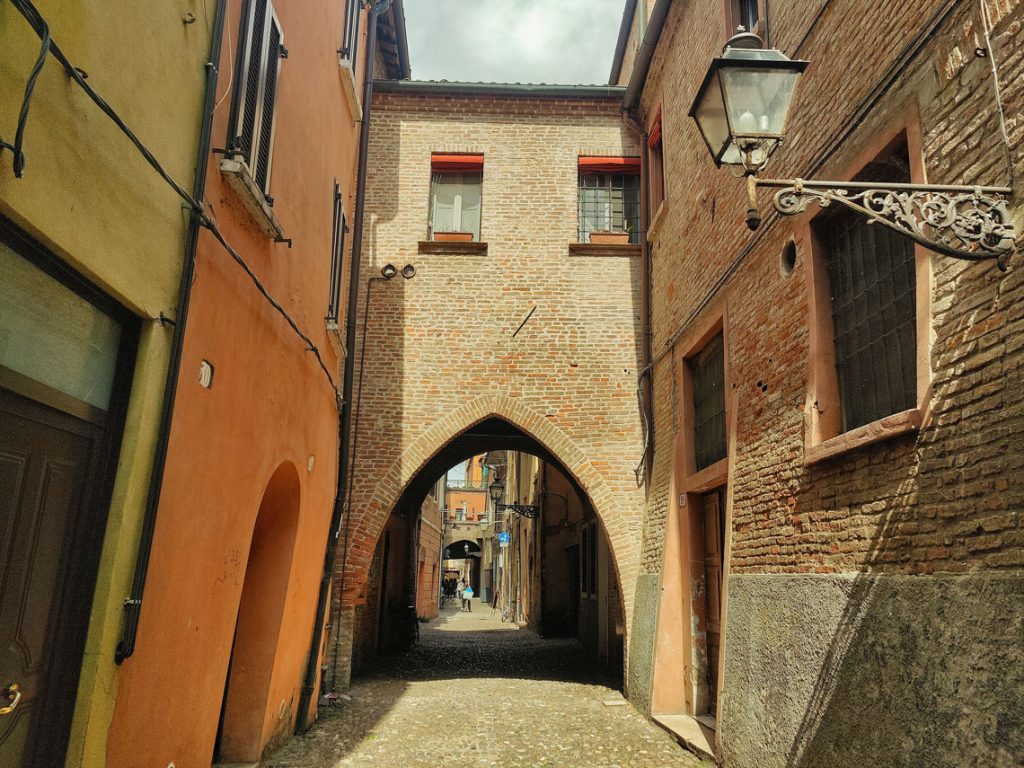
It used to be the commercial crossroads of the city and it was inhabited by the merchants with their warehouses. Thanks to these passages both merchants and owners could reach their shops and warehouses without going outdoors, avoiding crossing what was one of the most infamous streets in Ferrara, nice by day but full of prostitutes and criminals during the night.
Via delle Volte is one of the oldest streets in Ferrara and after the year 1000 it constituted a fundamental element for the development of the entire city.
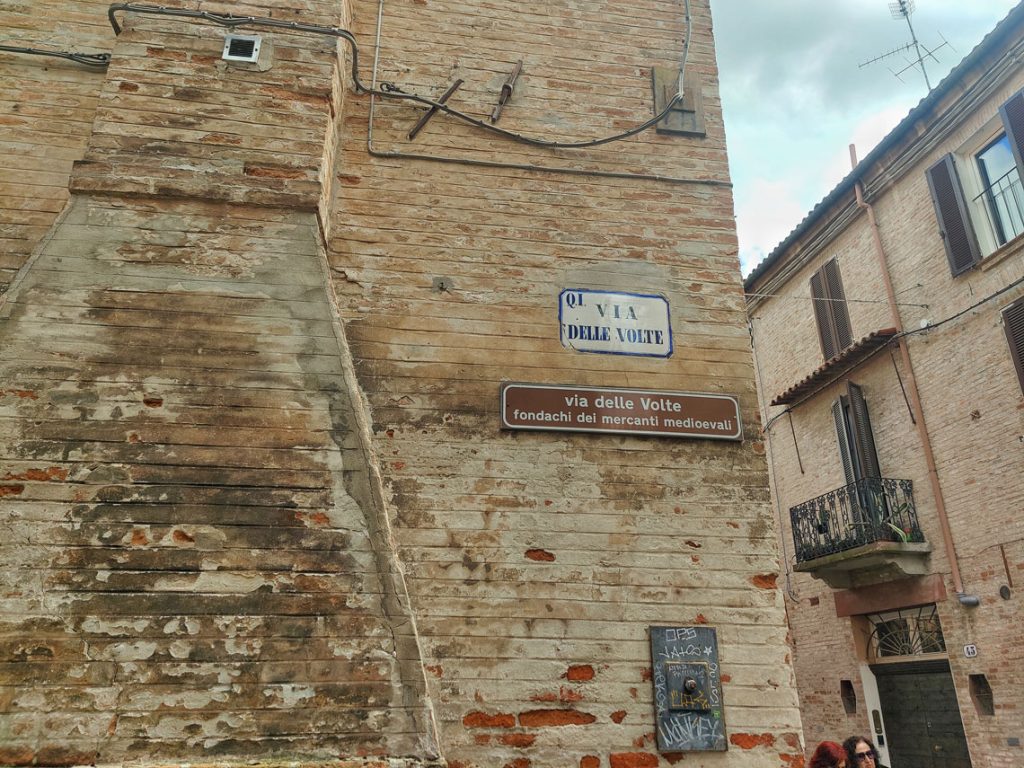
Today it hosts restaurants and shops selling local delicacies.
💡 Take a break at Il Mandolino – a typical trattoria with wooden beams where you can taste genuine dishes.
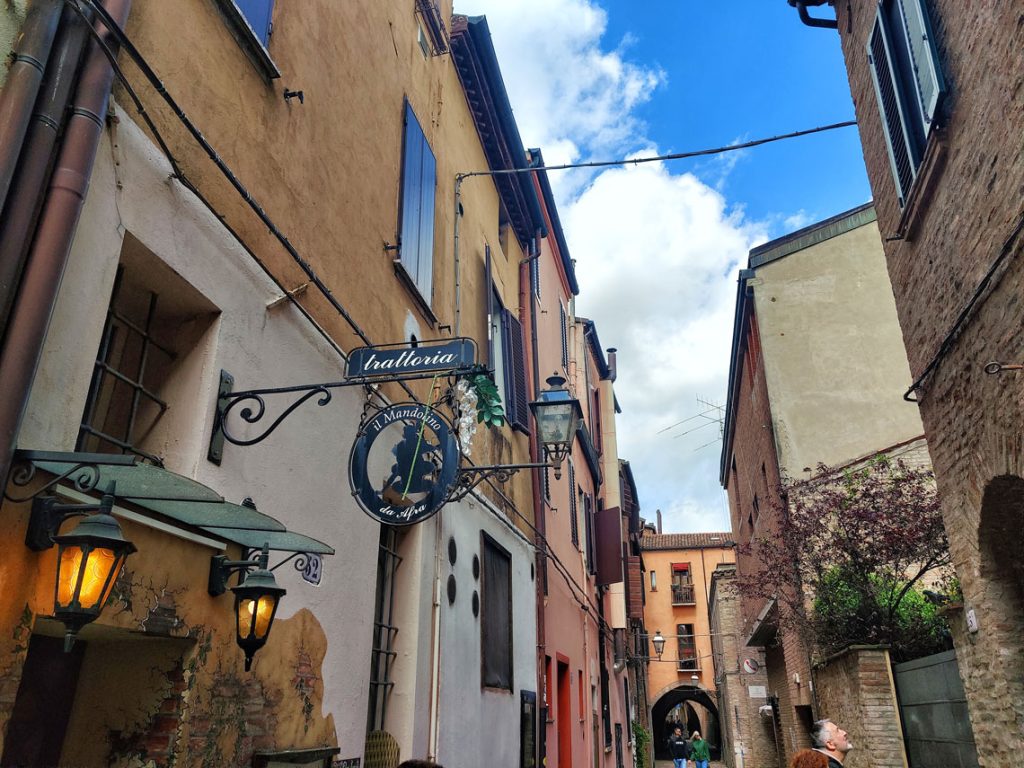
The Cathedral of Ferrara
From the long street Via delle Volte you can easily reach Piazza della Cattedrale and the Cathedral of San Giorgio Martire with a stunning white marble facade.
The church is a mix of styles as its structure bears impressions of all the historical periods of the city.
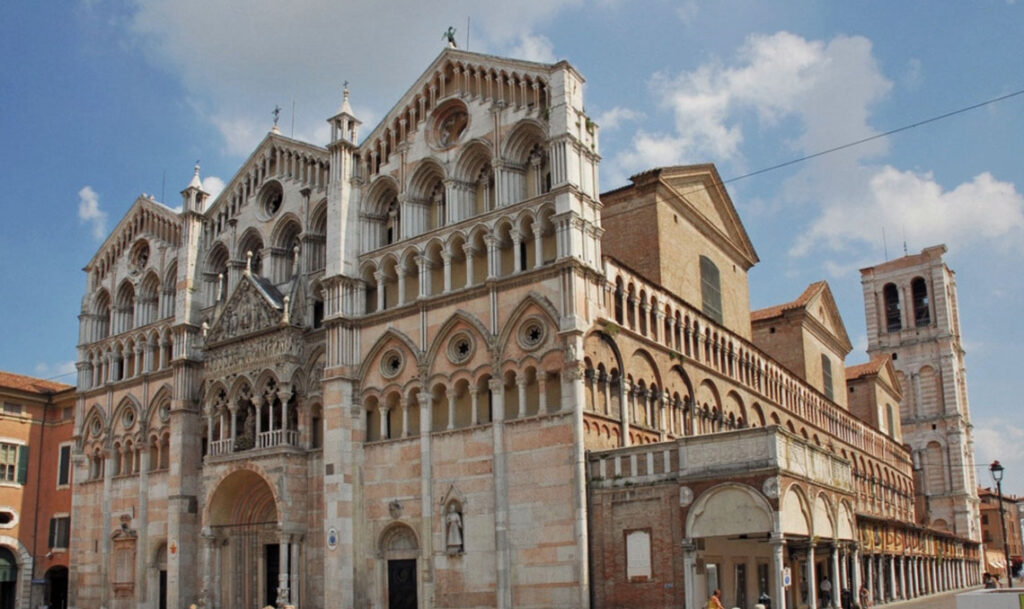
The lower part of the facade, with its three cusps, is in Romanesque style. Above the central door you can admire the scenes from the New Testament and the statue of Saint George (the protector of Ferrara) killing the dragon.
The upper part, built a few decades later, is in Gothic style and is characterized by numerous light arcades and splayed windows.
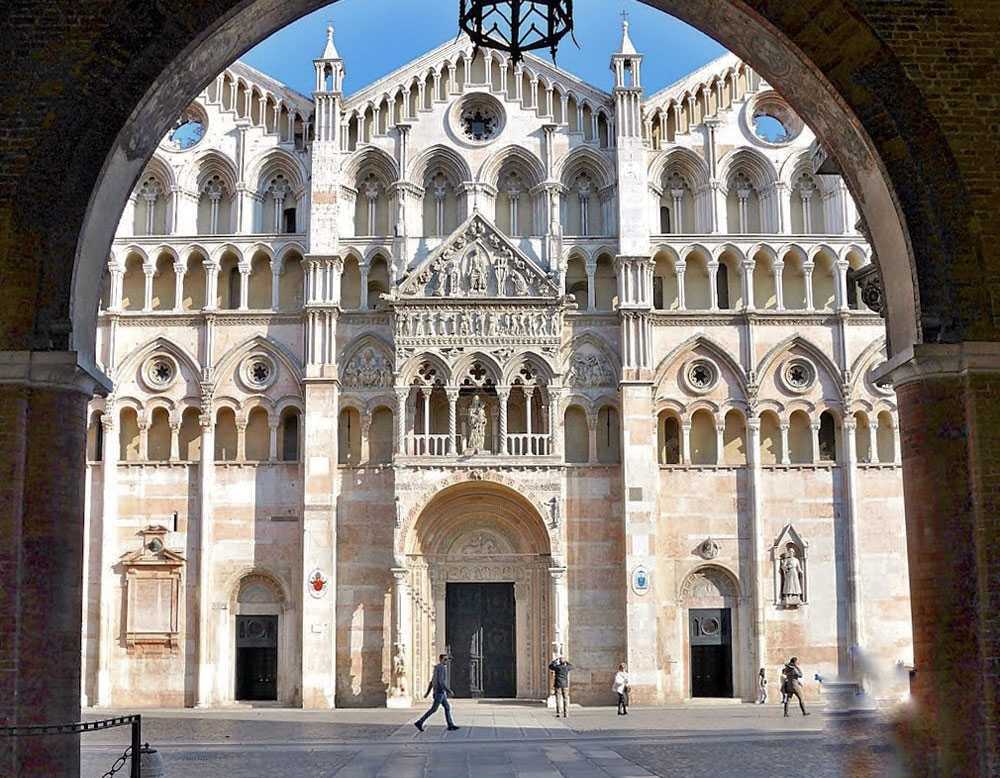
The three portals of the Cathedral symbolize the Trinity. The imposing main one, called Porta dei Principi, was opened only on solemn occasions for the passage of the Bishop, the Consuls or the Lord. The right portal was intended for the men’s entrance, while the left one was reserved for the women’s entrance.
The interior of the Cathedral is full of complex sculptures and variety of frescoes. The Last Judgement by Bastianino, located in the apse above the choir, which inspired by Michelangelo’s Sistine Chapel, is a true marvel.
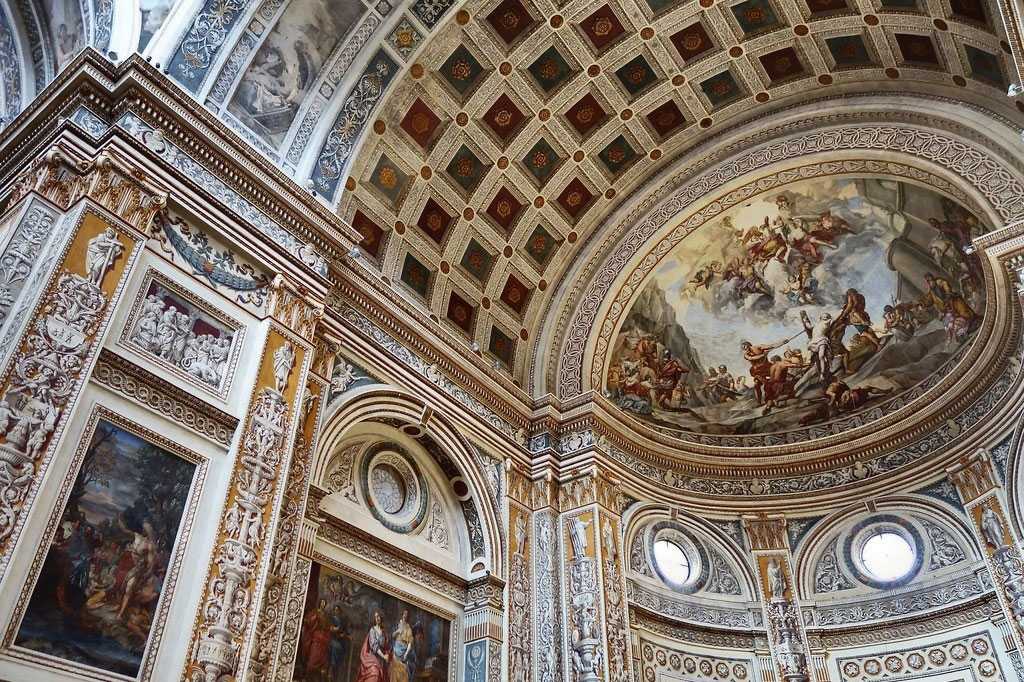 Costs: free admission.
Costs: free admission.
Piazza Trento-Trieste
Next to the Cathedral opens the main square of Ferrara Piazza Trento-Trieste. For eight centuries it remained the most popular and frequented place of the city where stood the main seats of economic, political and religious power.
Indeed, in addition to the Cathedral with the Bell Tower, there are the Town Hall, the Cathedral Museum, the Palazzo della Ragione, the Clock Tower and the Loggia dei Merciai. The lattest has always been dedicated to the bottegas of merchants and still houses modern shops and commercial activities.
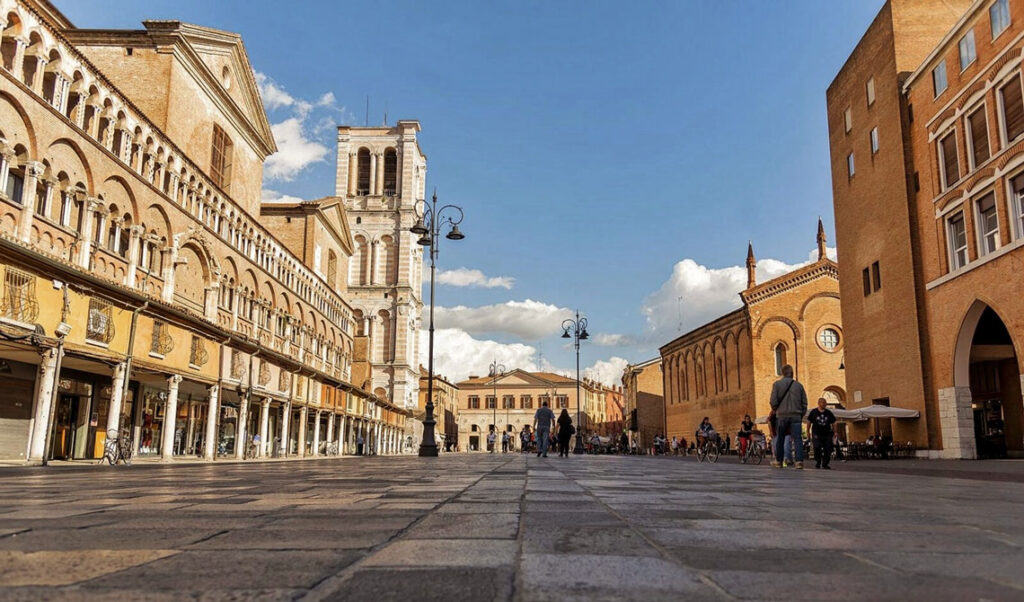
Thanks to the artificial lighting, the Square offers a spectacular effect even in the evening, when the monuments flaunt all their charm.
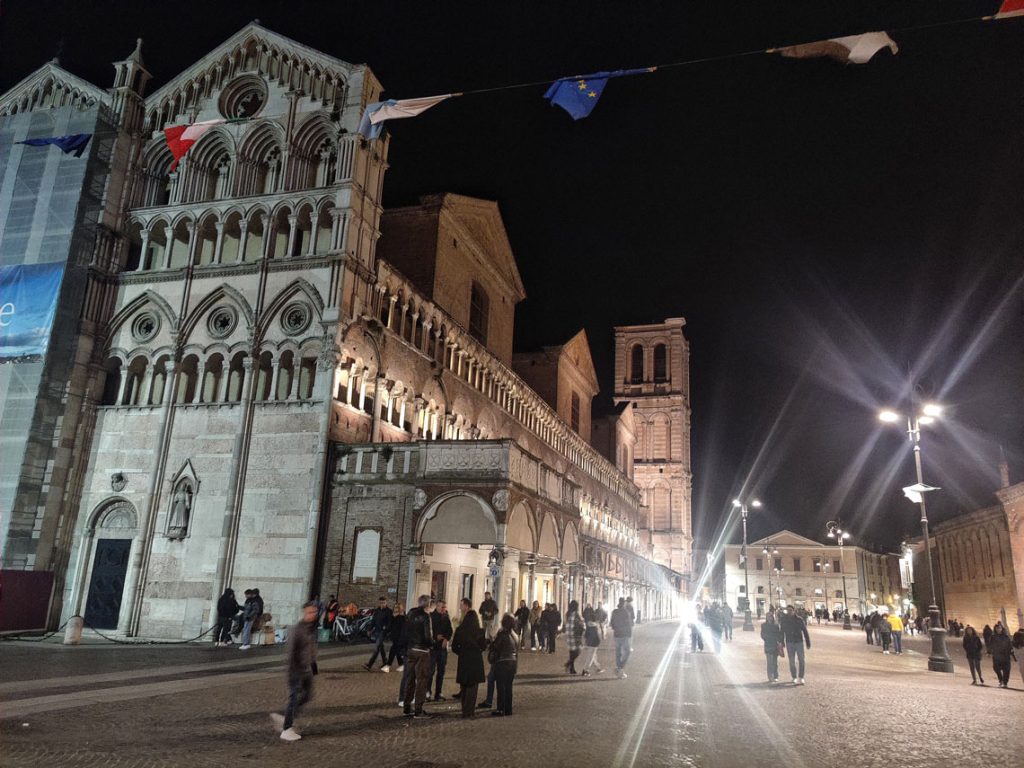
Right on the square there is a historic pasticceria Leon D’oro, a perfect place for a sweet pause or for a local aperitif.
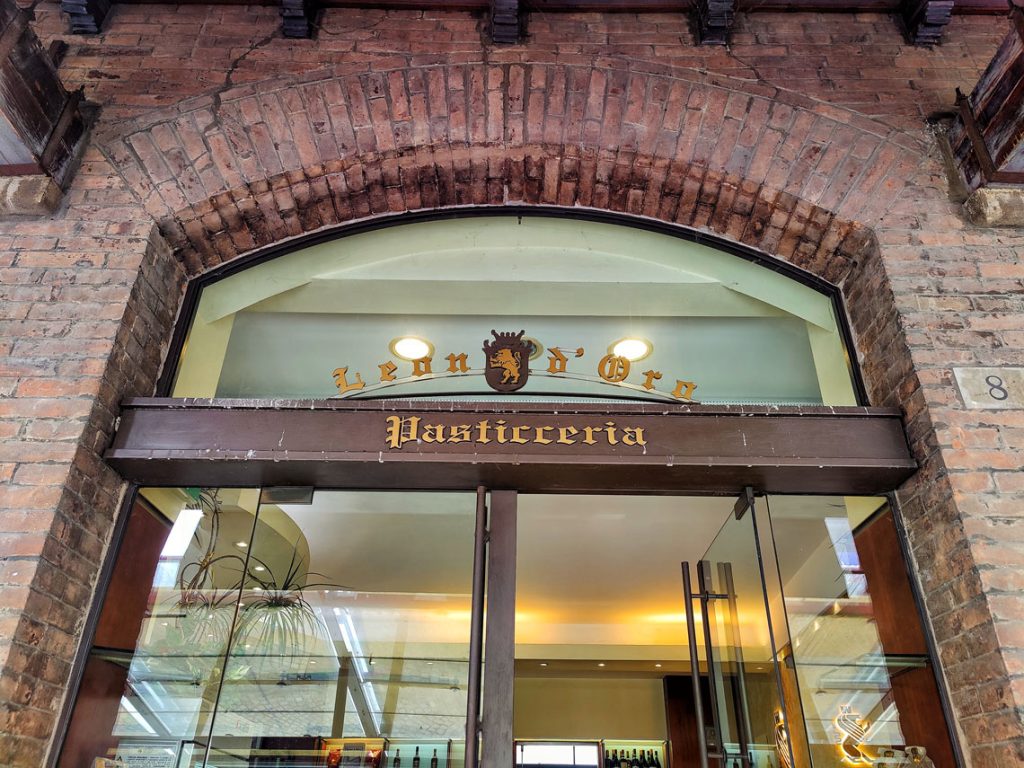
The incomplete Bell Tower
Walking along the ancient Loggia dei Merciai you can’t fail to notice the tower bell 45 meters high. It is a Renaissance type bell tower located in the south side of the Cathedral, built with brickworks and covered with limestone. The columns on the north and south sides are in grey limestone of Noriglio, the skirting of the columns is in Istrian stone, the capitals of the columns are in prun stone and some coats of arms on the south and west sides are in soft stone of Vicenza.
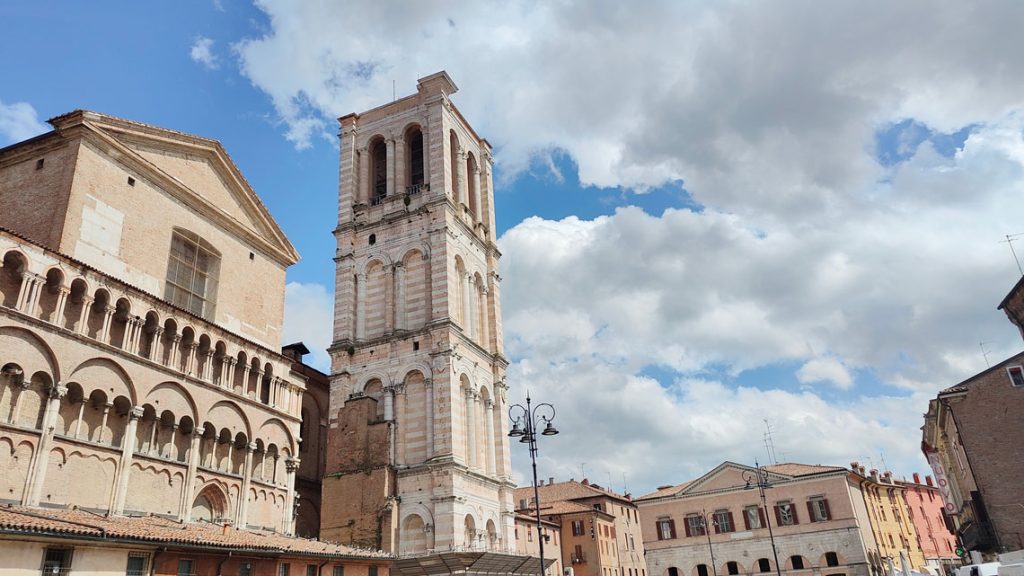
The original design is attributed to the famous architect Leon Battista Alberti, the works took place in the second half of the fifteenth century between 1451 and 1453 but had never been defenitly completed.
The Cathedral Museum of Ferrara
A few steps from the cathedral of San Giorgio, in the former church of San Romano you find the Cathedral Museum of Ferrara.
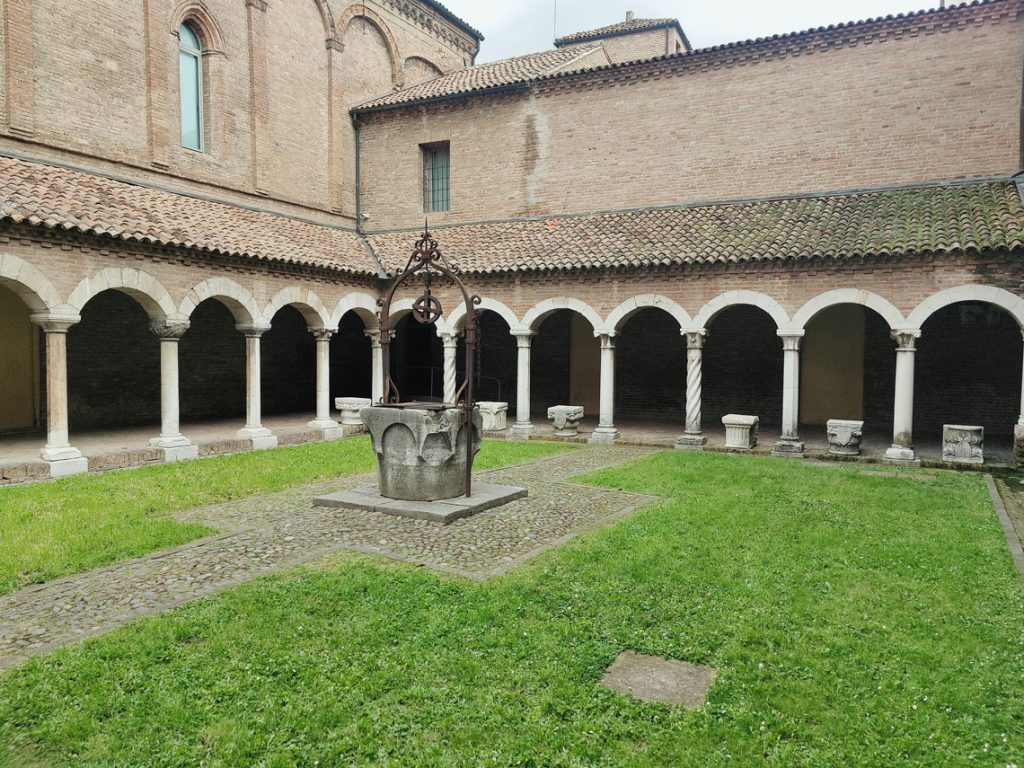
The Museum consists mainly of works originally exhibited in the Cathedral, such as organ doors, sculptures, paintings. Here is also preserved the majestic Madonna of the Pomegranate by Jacopo della Quercia.
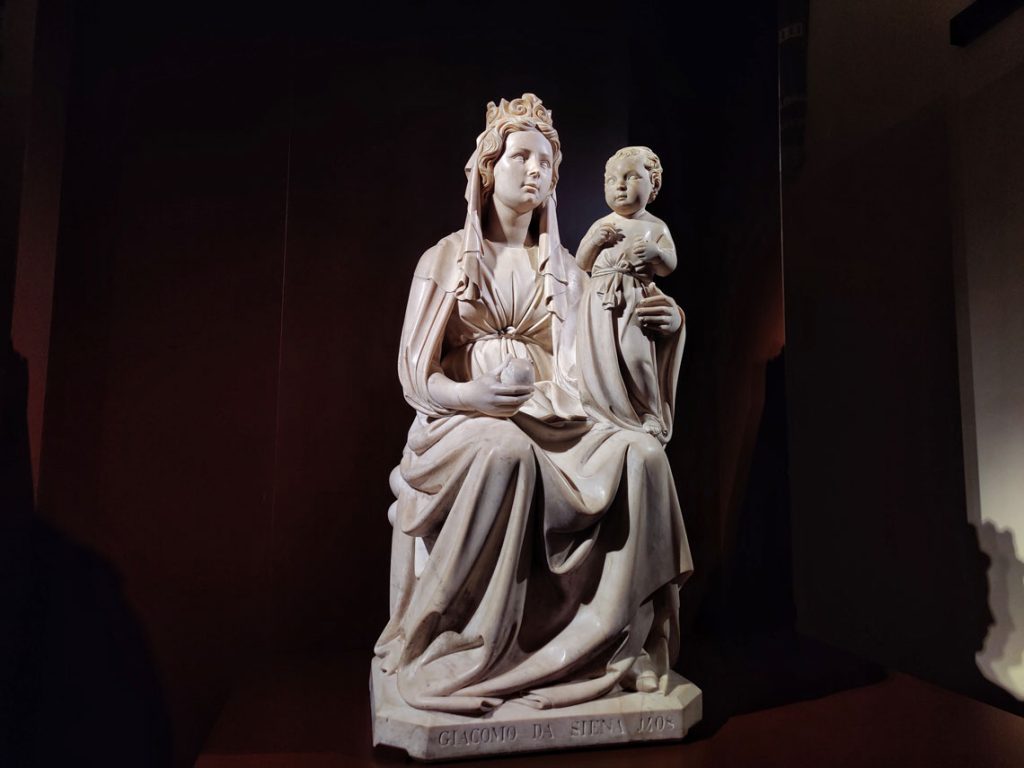
A visit to the Cathedral Museum of Ferrara is also a must to discover the original design of the Bell Tower and to find out how exactly it would have looked like if once have been finished.
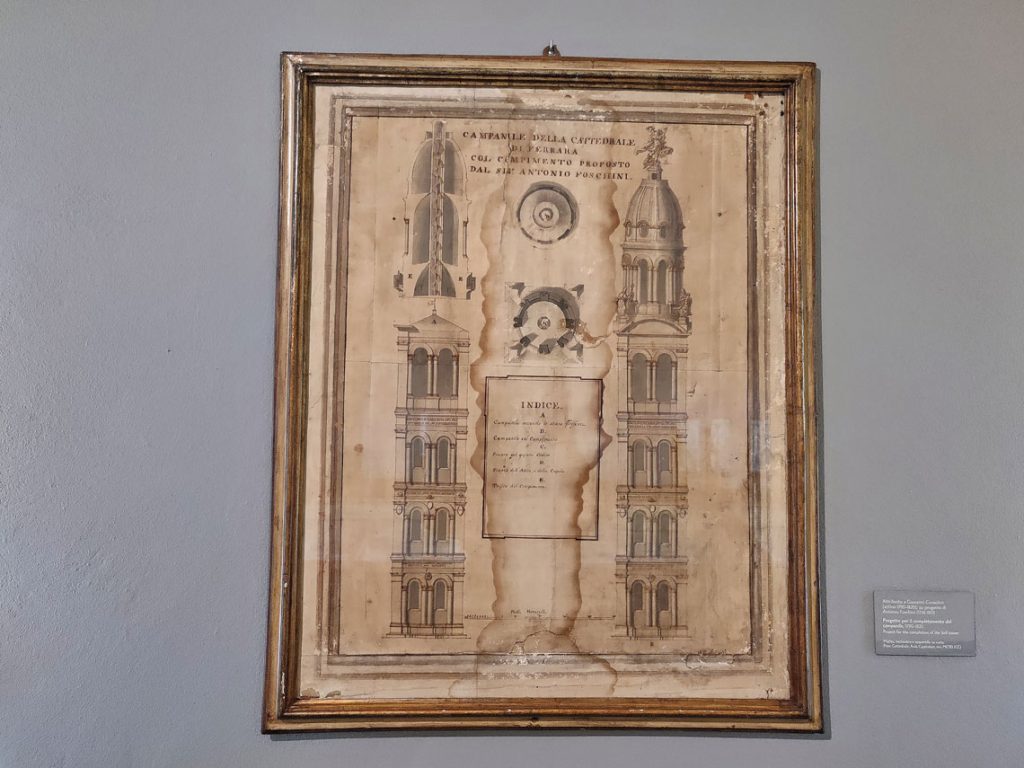
Admission: 6,00 € full price, 3,00 € reduced.
Piazza Municipale
From Piazza Trento-Trieste pass through the arch to find yourself in front of Piazza Municipale. This small and pretty square, dominated by the magnificent Grand Staircase of Honour of white marble, was once the courtyard of the Doge’s Palace.
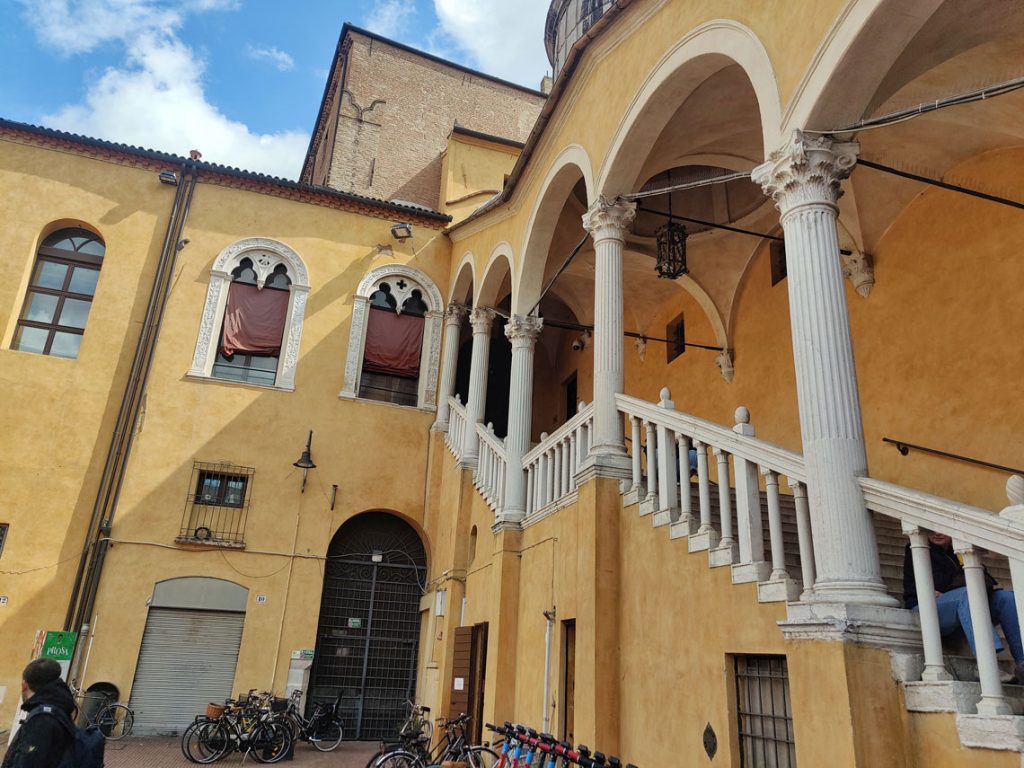
Built according to a design by Pietro Benvenuto in 1481, the staircase is characterized by a vaulted roof with central dome and arches in Renaissance style, while the marble balustrade has medieval Gothic elements. From the stairs you can enjoy a complete view over the lively square.
The Estense Castle
It is time to continue towards the symbol of Ferrara: the Estense Castle. Its importance and beauty make it the star of souvenirs and postcards. The castle encloses within its walls over six hundred years of history!
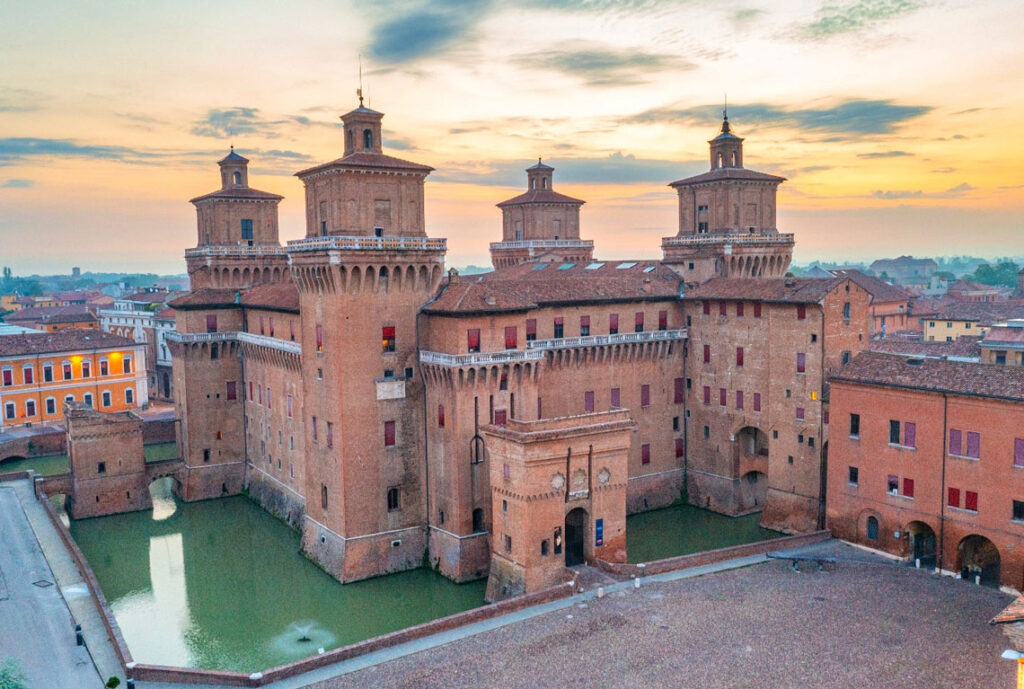
Surrounded by the moat and four towers it still constitutes a rare example of architecture. Built in 1385 by Nicolò II d’Este as a fortress for the defense of his family, over the years the castle underwent a series of changes that transformed it into a splendid court residence rich in important collections (paintings, tapestries, fine objects, illuminated codes, coins, weapons).
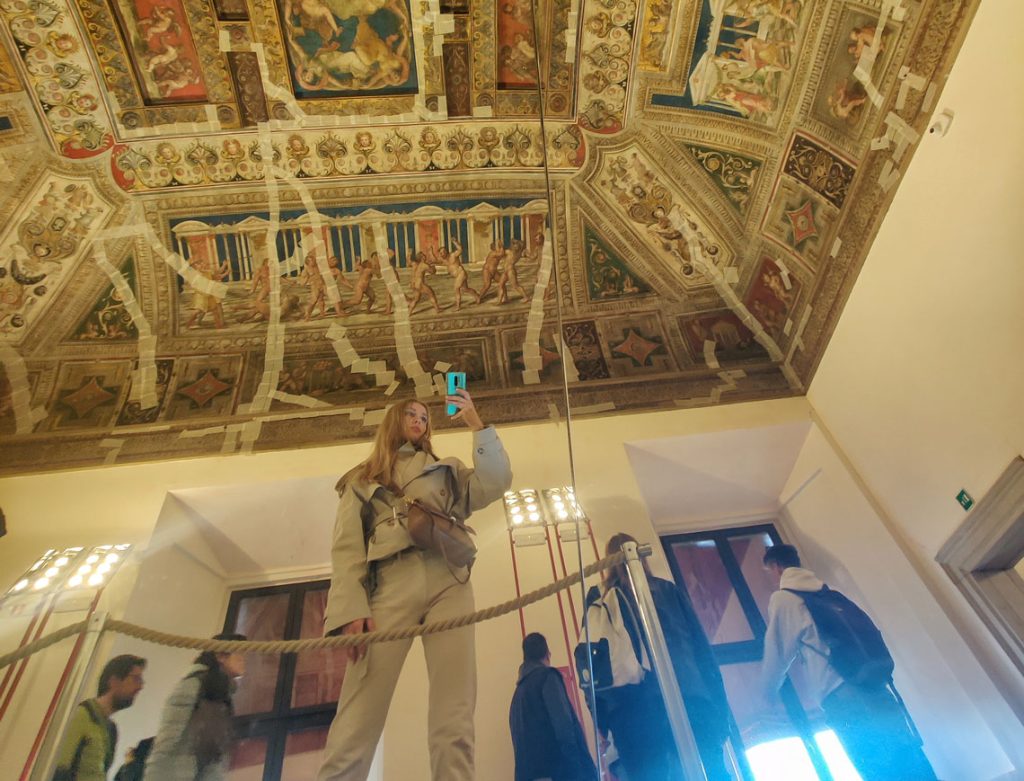
The Castle Museum, set up here by the architect Gae Aulenti, offers a narrative path that allows you to deepen your knowledge of the building and the history of the Estensi family.
Do not miss the climb to the Torre dei Leoni – the oldest tower of the Castle. Along 120 steps you can have the most panoramic view of Ferrara from above.
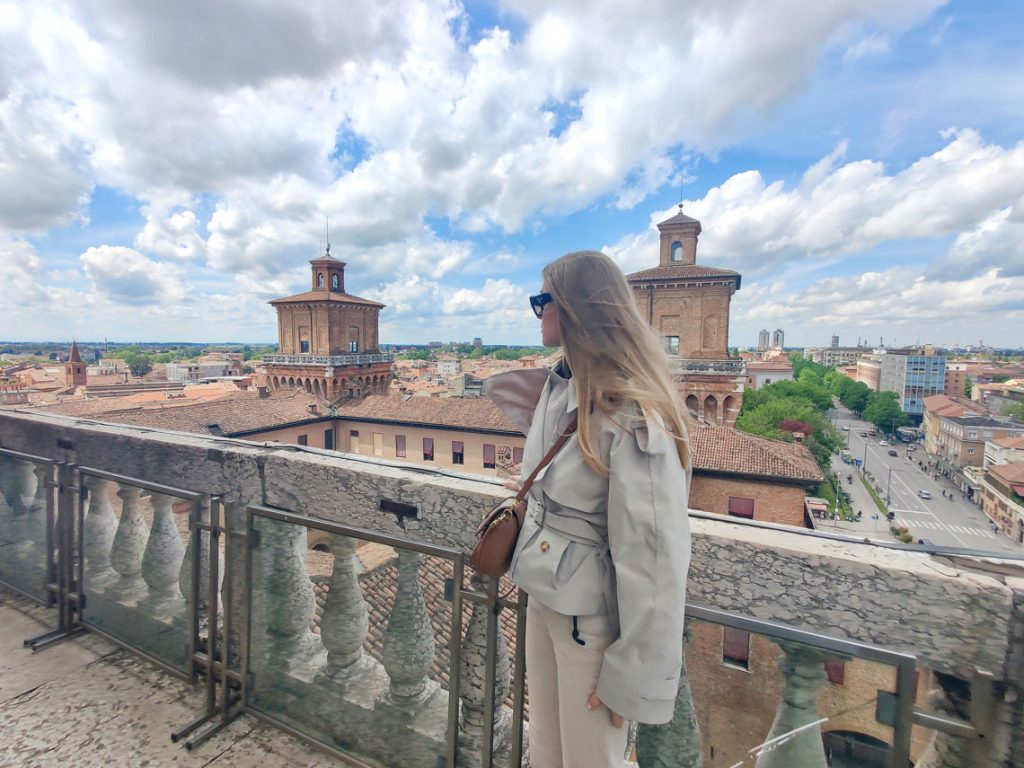
In the castle you can discover the apartments, kitchens, prisons, the garden, the chapel and much more.
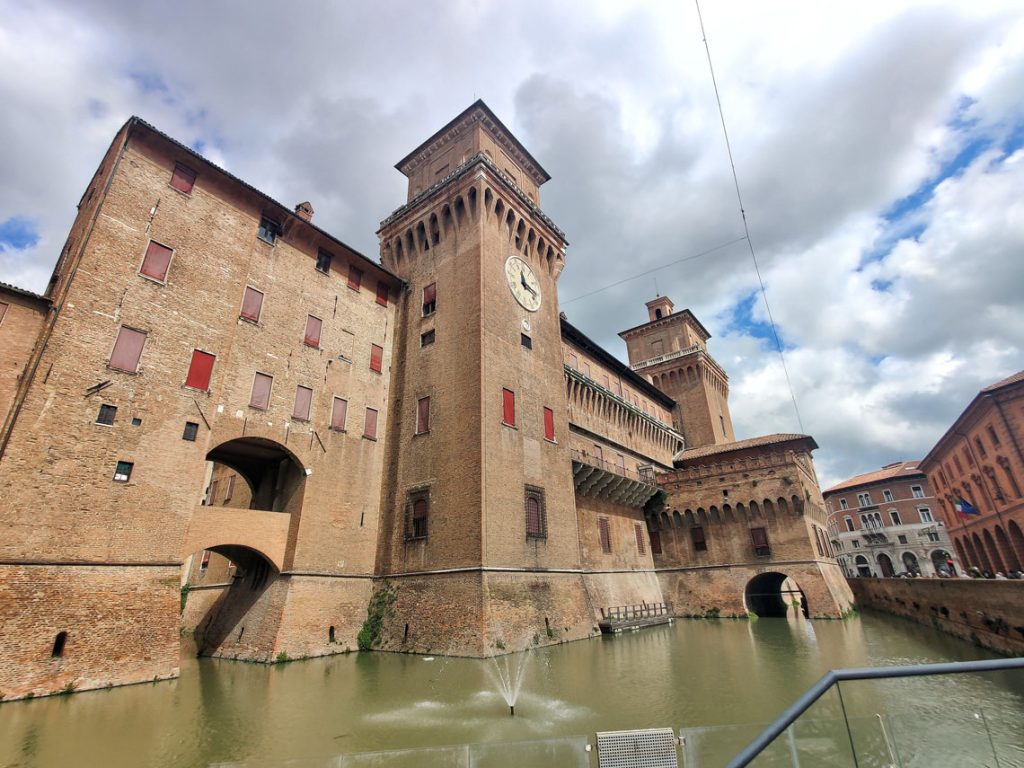
Admission: full price €8.00 / Reduced price €6.00 / Supplement €2.00 for Torre dei Leoni
La Rotonda Foschini
On the opposite corner to the Estense Castle there is one of the magical places of Ferrara, a small oval courtyard that has to be admired by gazing upwards.
The Rotonda Foschini is a part of the Municipal Theatre and was designed for the passage of carriages. It has two entrances: one on Corso Giovecca and one on Corso Martiri della Libertà. It is well worth to stop here at sunset. Stand out in the middle, look up and admire the magnificent spectacle of the firmament!
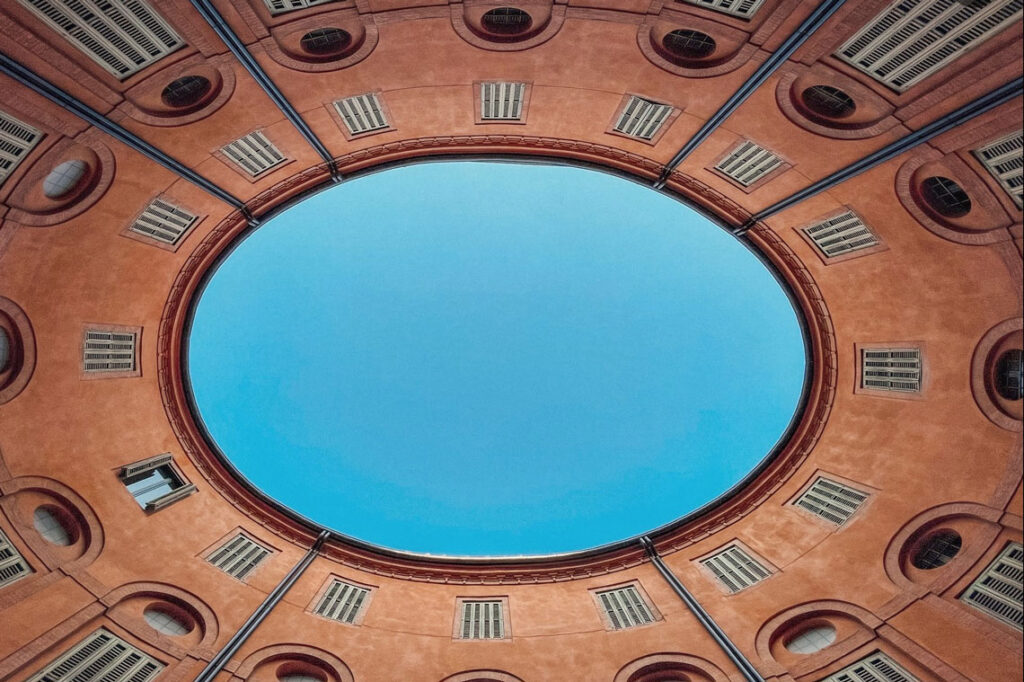
Padimetro
Not far from the Castello Estense, in Piazza Savonarola on a column of a building in the historic center, there is the Padimetro – a monument that marks all the various heights the level of the River Po’ reached during the most serious flooding. The most impressive and devastating one happened in 1951, when the Po river reached 8 meters and 51 centimeters!
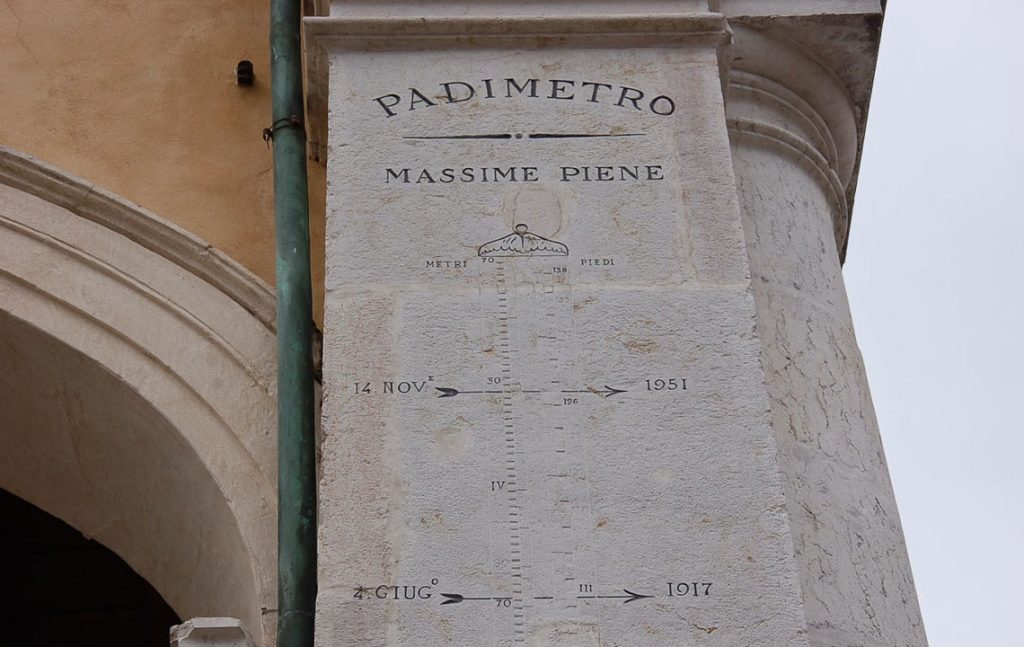
Palazzo dei Diamanti
Looking at this building is enough to understand why it is called the Diamond Palace. It takes its name from the rusticated exterior of its walls, composed of eight thousand five hundred blocks of white marble with pink veins, hewn like a multi-faceted diamond. The work on the Palace started in 1495 on behalf of Sigismondo d’Este, the brother of Duke Ercole I of Este and the project was entrusted to Biagio Rossetti.
💡 Interesting to know
A legend tells that in one of these blocks is hiden a real diamond by Ercole I d’Este ( a gem of his own crown).
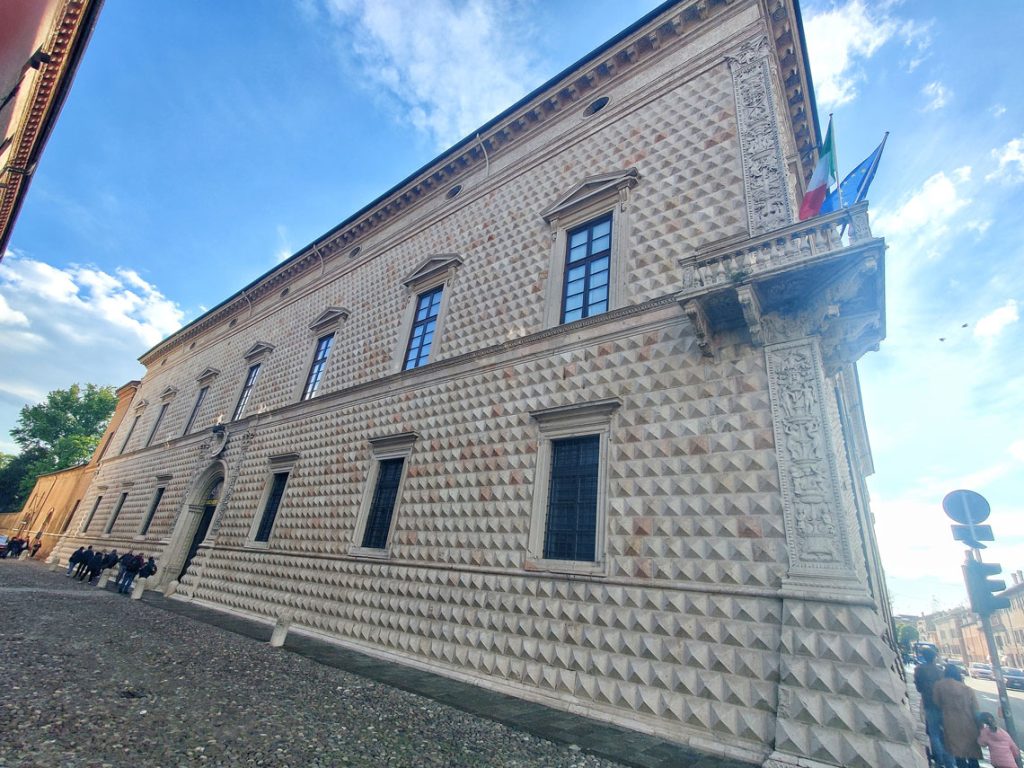
The idea of Rossetti was to insert the Palazzo dei Diamanti in the Quadrivio degli Angeli, to erect a stylistically graceful building which stood at the center of the Herculean Addition.
Historically the Palazzo dei Diamanti in Ferrara has not undergone large structural changes from the original project: only in 1641, when Palazzo dei Diamanti was sold to the family Villa, the candlesticks were placed on the sides of the entrance to the Palace.
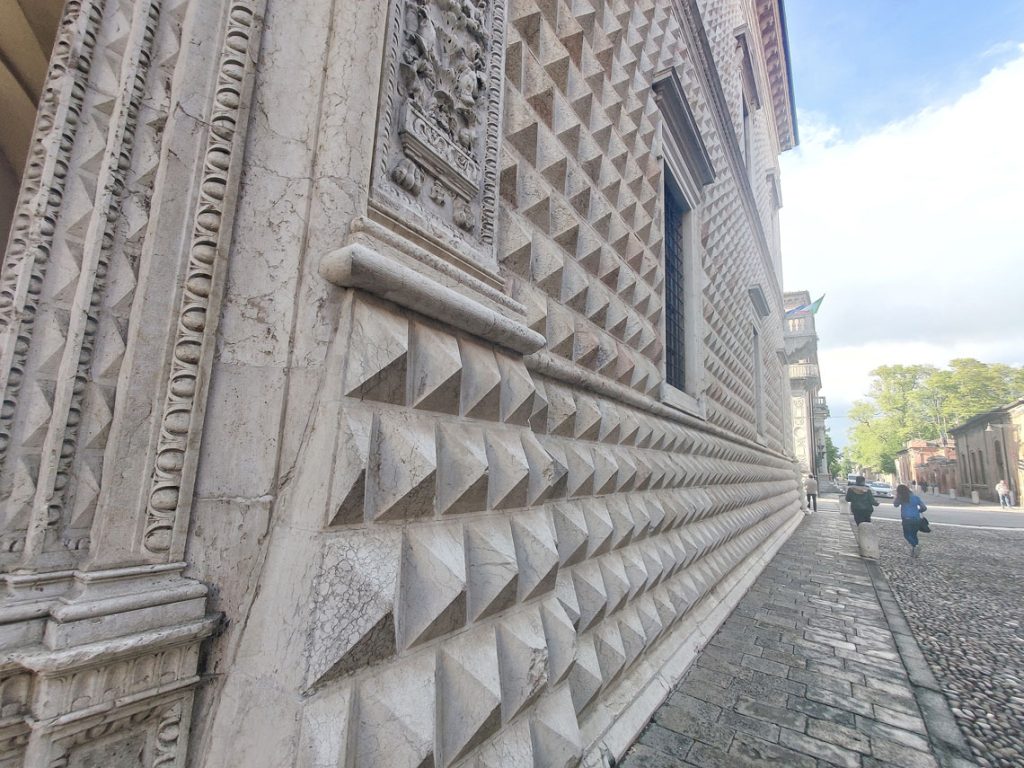
The interior of the building reflects the typical structure of the Renaissance palaces of Ferrara, with a loggia around the courtyard and a with marble well in the center.
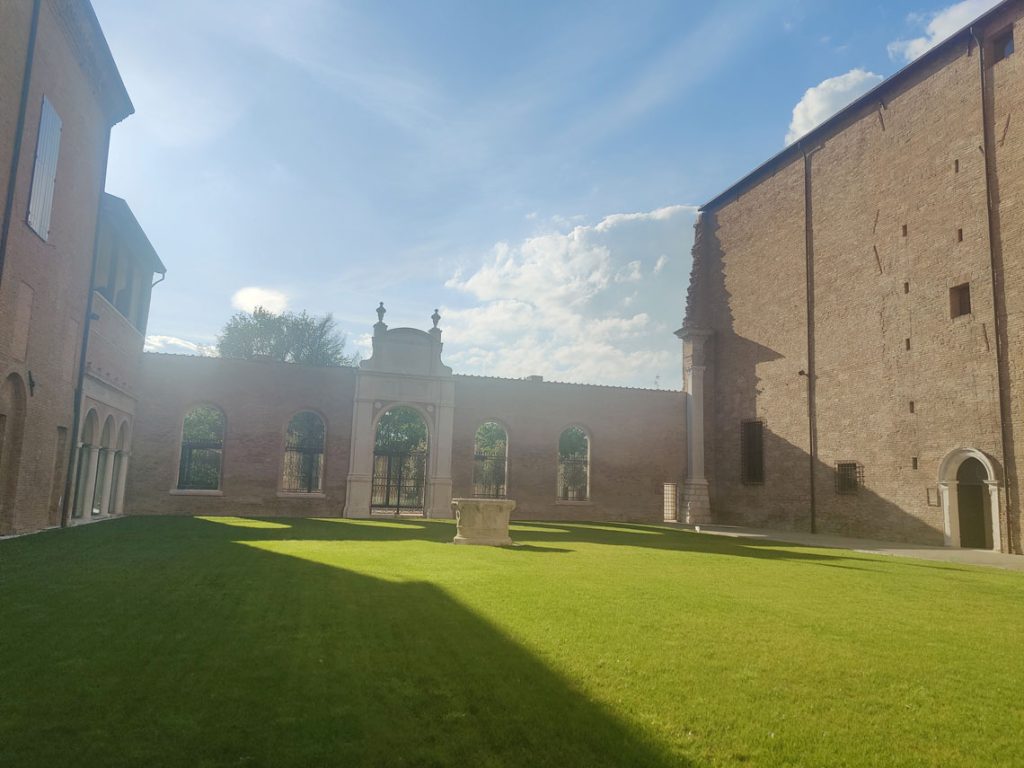
Since 1842 the Palazzo dei Diamanti has been owned by the Municipality of Ferrara and it hosts the Pinacoteca and the University of the city, as well as the space to set up important art exhibitions that attract visitors from all over the world.
Costs: full price €13.00 / reduced price €11.00
Corso Ercole I d’Este
A few steps from Palazzo dei Diamanti there is Corso Ercole I d’Este. It has been defined by UNESCO as one of the most beautiful streets in the world. A charming street in Renaissance style made of elegant buildings, doors and decorated windows. Completely pedestrian and without shops.
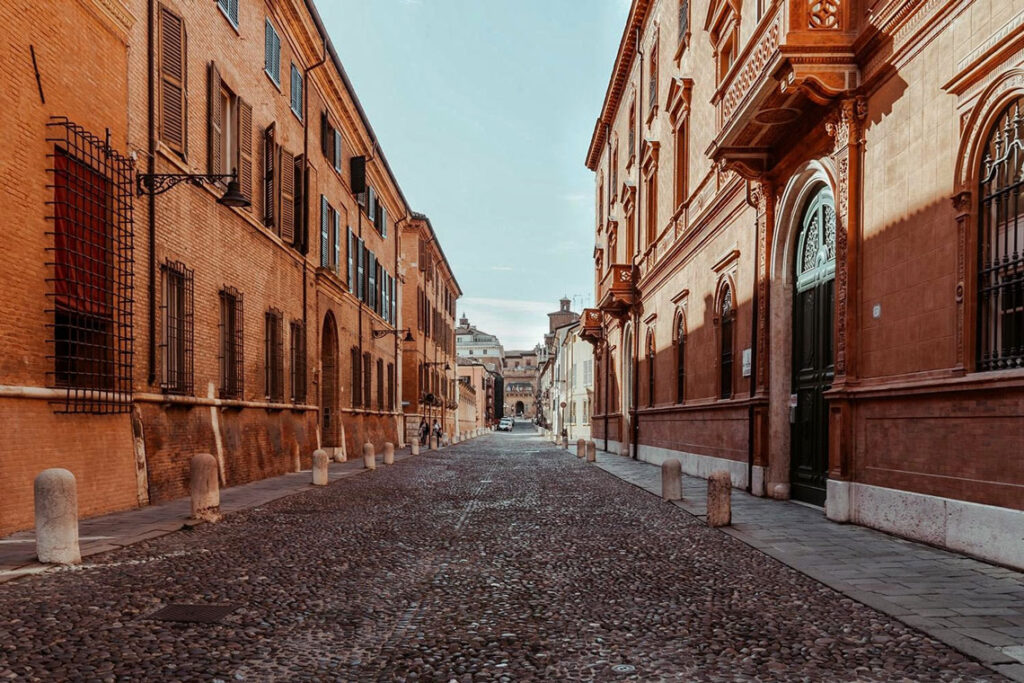
The most important point is the so-called Quadrivio degli Angeli, where Corso Ercole I d’Este meets Corso Biagio Rossetti. Here visitors encounter four splendid palaces for four corners: Palazzo dei Diamanti, Palazzo Pallavicini, Palazzo Prosperi-Sacrati, and Palazzo Turchi di Bagno.
Parks and gardens of Ferrara
If you walk through the city during the hottest hours of the day you may find some refreshment in one of the parks and gardens. Here I will mention the Massari Park, which covers about 4 hectares and was designed in 1780 by the architect Luigi Bertelli, the urban park Giorgio Bassani and the Pareschi Park.
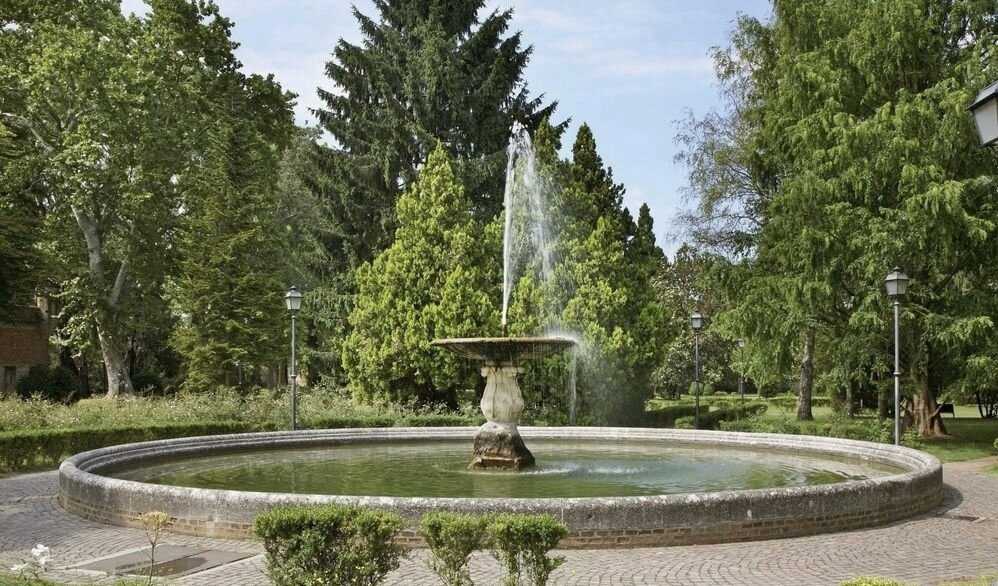
What to taste in Ferrara
After nourishing your mind and spirit with the artistic beauties, it is time to delight the palate as well 😋. The gastronomy of Ferrara is a dive into history and culinary art. The typical dishes bring the scent of ancient preparations and combinations of flavors, dating back to the times of the noble Renaissance courts.
Cold cuts are the pride of local cuisine and the salama al sugo is definitely worth tasting – a sausage made of pork, mixed with salt, pepper, wine and spices, enclosed in a bladder of pork casing and left to mature for months.
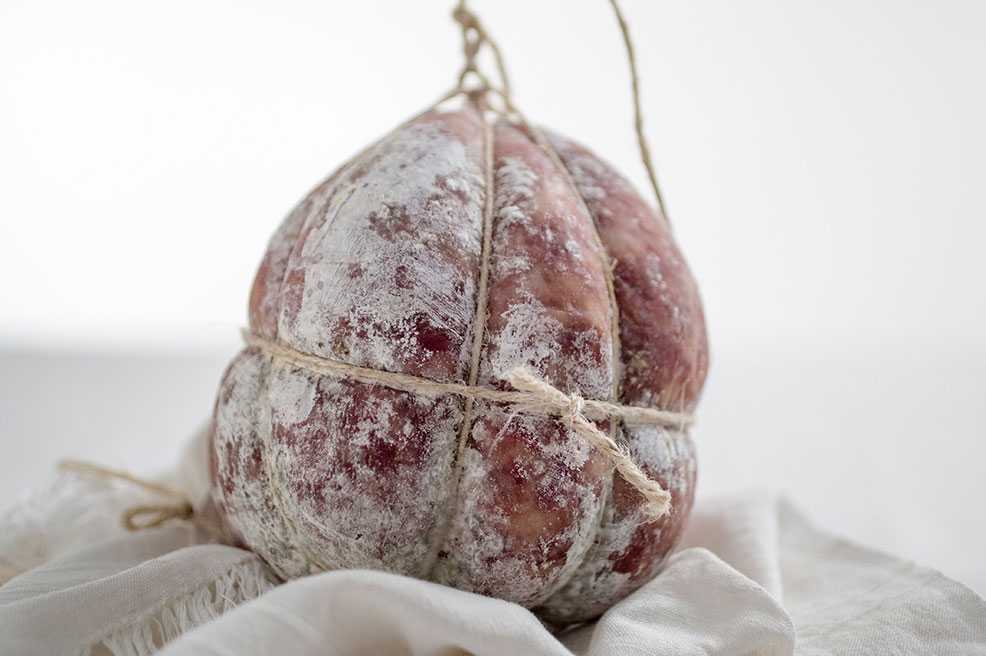
How not to mention the so-called pasticcio ferrarese – a delight in shortcrust pastry with a filling of macaroni (maccheroni), seasoned with meat sauce, mushrooms, béchamel, truffle and nutmeg.
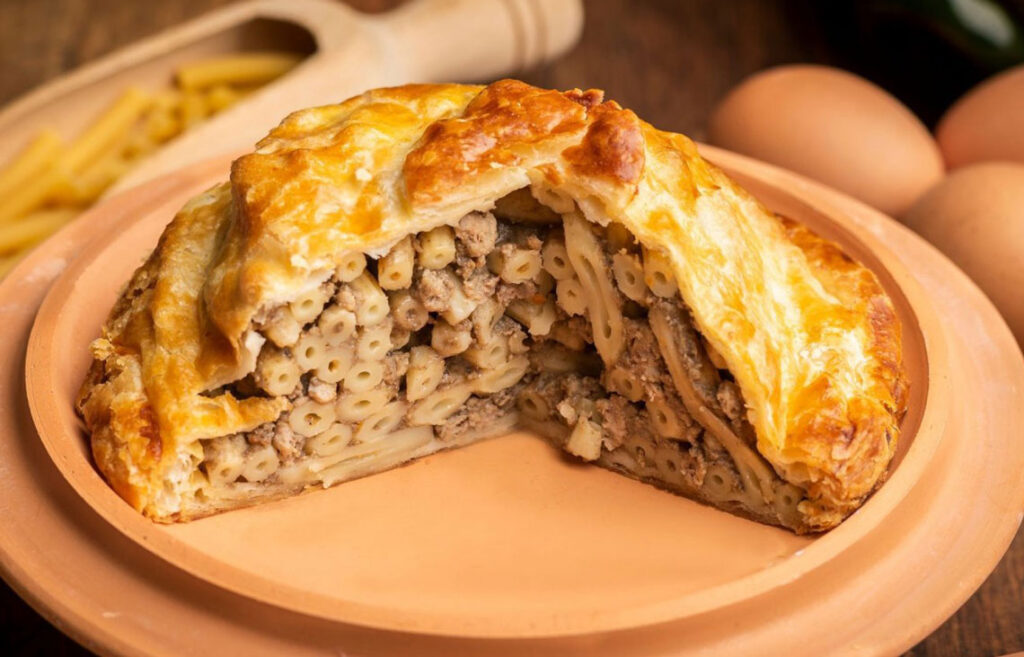
Unmissable the cappellacci di zucca (fresh pasta rivioli filled with pumpkin) and the coppia ferrarese bred (two cornets joined together) crusted outside and a soft inside.
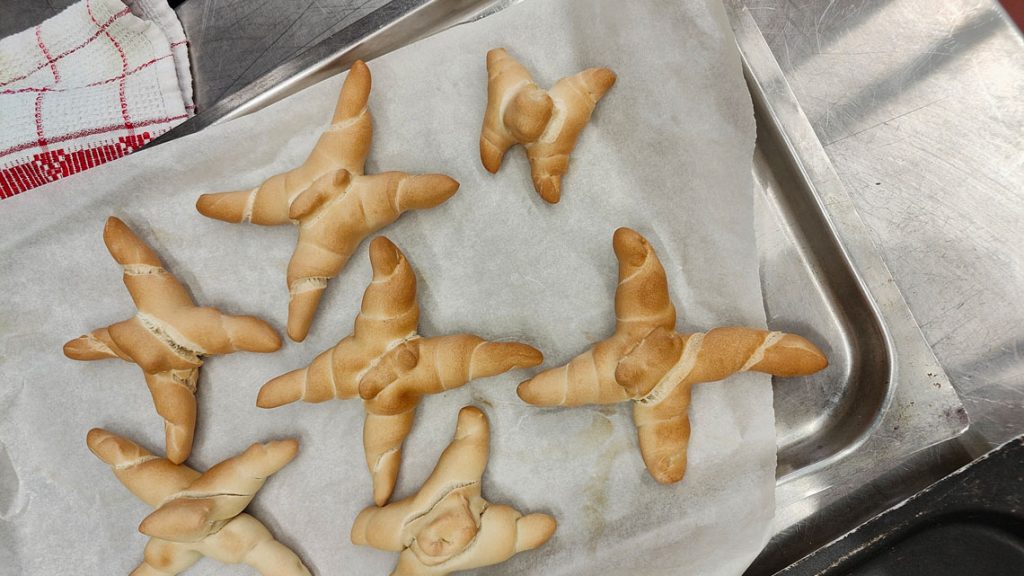
For sweet lovers Ferrara’s cuisine offers a variety of cakes such as tenerina – a soft chocolate cake inside and crunchy outside; panpepato – a dark chocolate cake with almonds or hazelnuts, candied fruit and scented spices and the legendary brazadela – the typical donut from Ferrara.
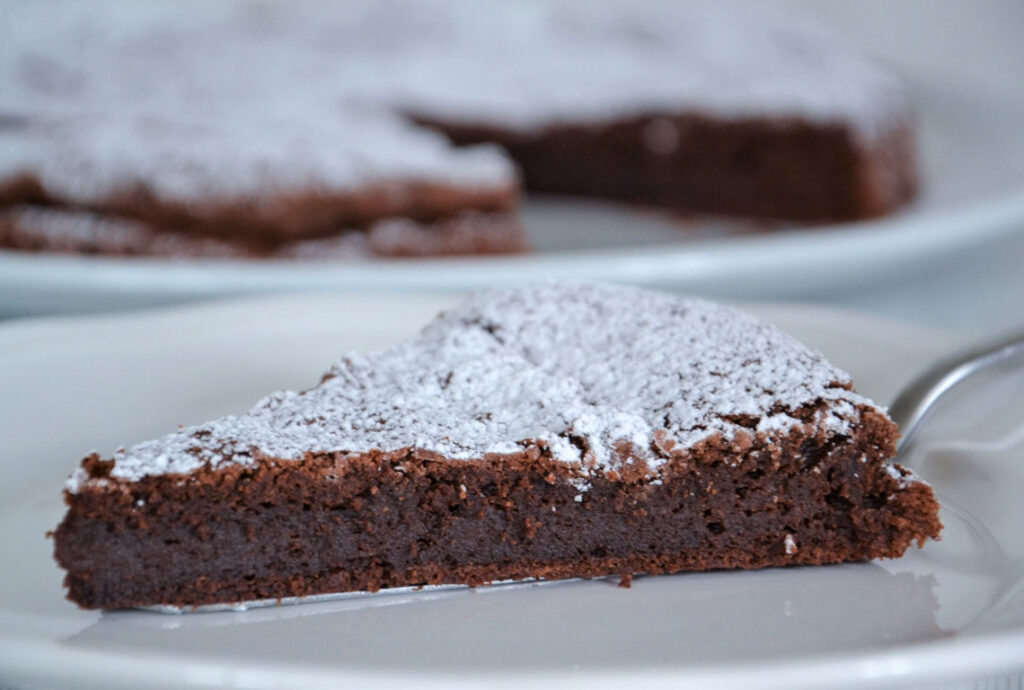
The oldest tavern Al Brindisi
One more thing you should definitely do in Ferrara: stop by for an aperitif at the oldest tavern in the world called Al Brindisi. It is located in an alley next to the Cathedral, on Via Adelardi, and has a history of almost 600 years.
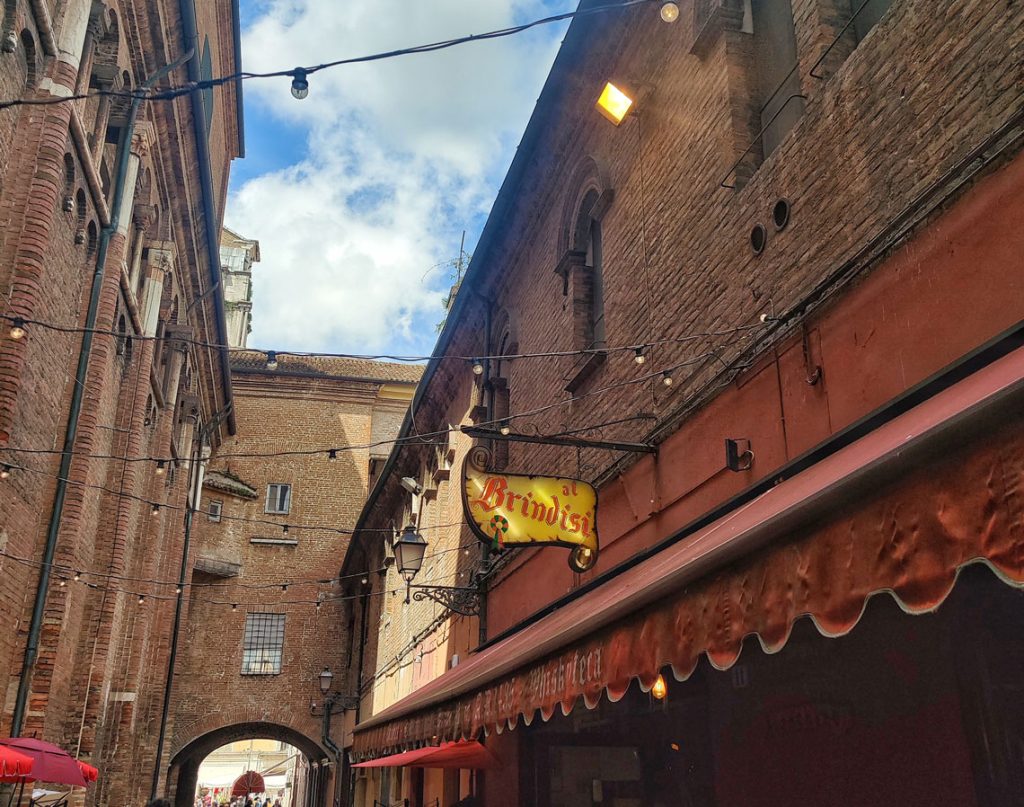
Originally called Hostaria del Chiuchiolino, the place was declared a historical tavern of Italy by Guinness Book of Records. The first written documentation, in fact, dates back to 1435 and among the famous people who attended there were the writers Ludovico Ariosto as well as Torquato Tasso.
The place is very popular not only by tourists but also by the locals so better to arrive early. Today it is a popular wine bar where you can enjoy excellent dishes and snacks of the culinary tradition of Ferrara, including cappellacci with butter and salama da sugo accompanied by a wide variety of excellent local wines like Bosco Eliceo or sand wines produced in the eastern part of the province of Ferrara, Comacchio and coastal areas of Lidi.
Address: Via Guglielmo Degli Adelardi 11, Ferrara
Tasty local dinner at Trattoria da Noemi
This restaurant received a Michelin star for its modern yet classic cuisine in 2021. In my option one of the best place where to taste the specialties of Ferrara.
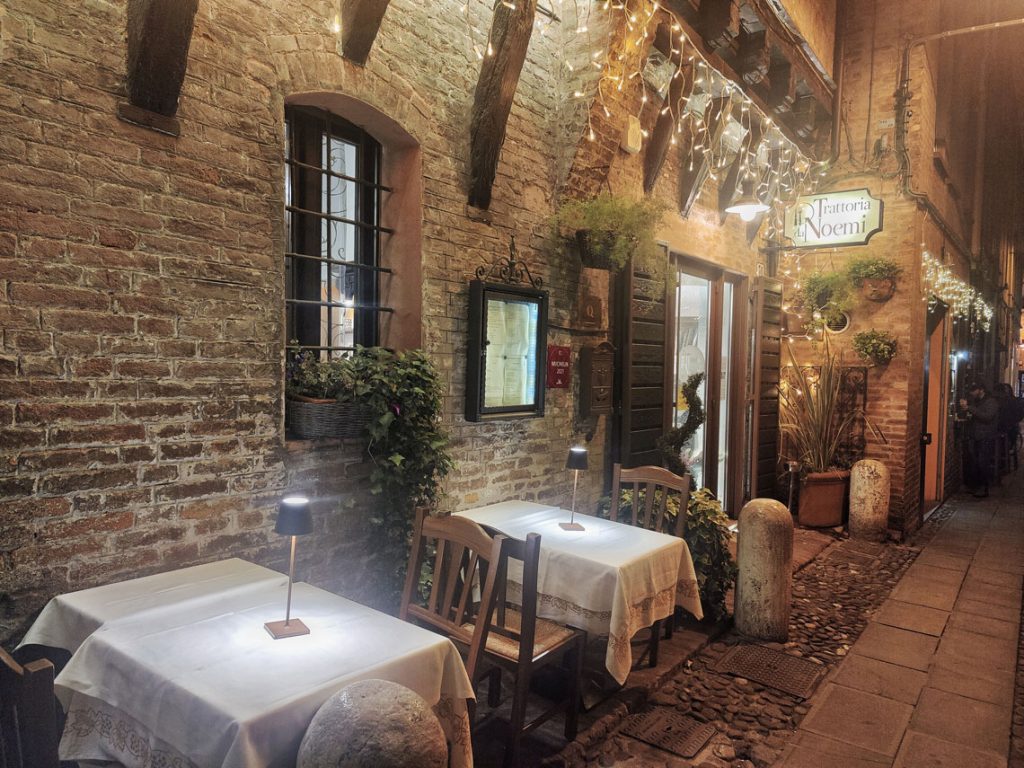
At Trattoria Da Noemi the food is excellent, the pasta is always homemade and prices are in line with the quality of the products.
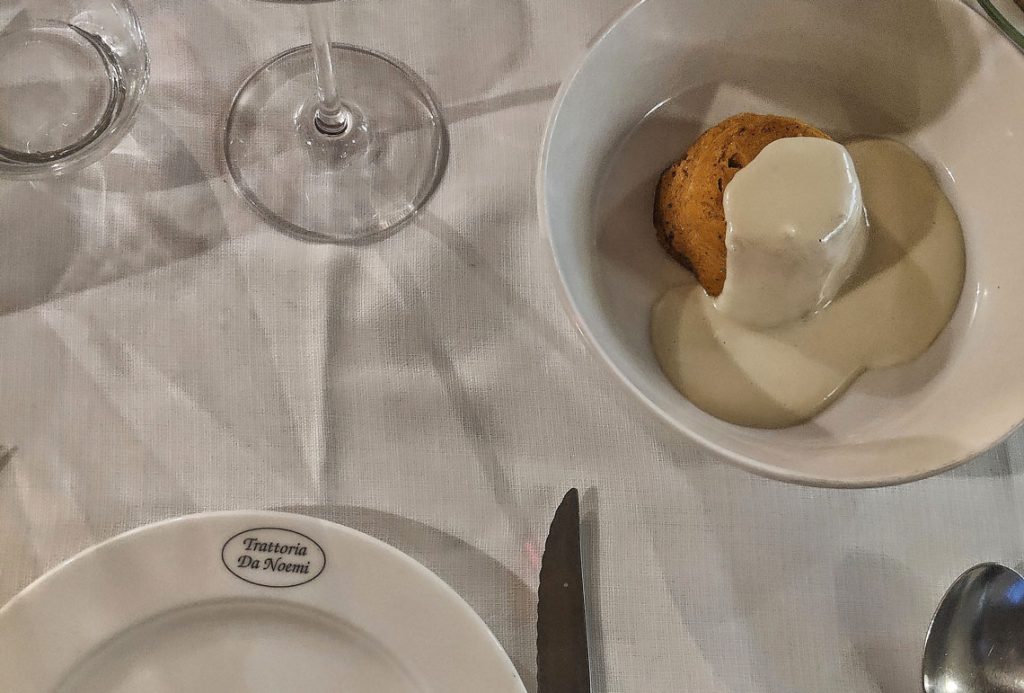
From appetizer to dessert all is delicious: pumpkin flan, pumpkin gnocchi with parmigiano, green cappellacci with spinach and gorgonzola, tenerina and apple pie, all is mouth-watering. The owner Mari Cristina is very kind and carries on the teachings and the tradition of her mother Noemi. Lunch or dinner it doesn’t matter, you must try it!
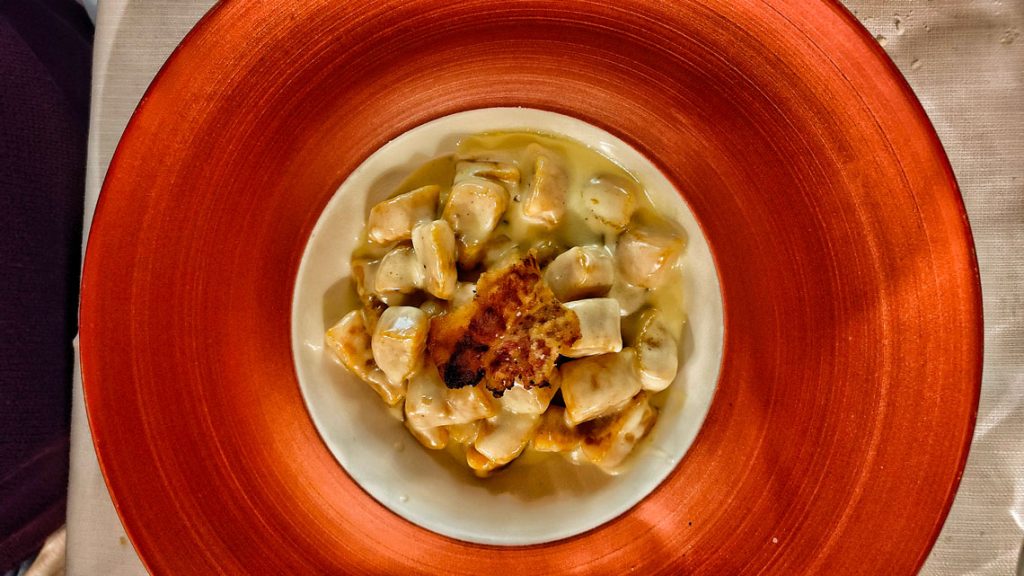
Cooking experience in Ferrara
If you are curious like me to know how to cook the same dish tasted at the restaurant I recommend you a cooking experience first-hand with a professional local chef🧑🍳. I personally love to come back from a trip and bring back with me a new recipe to surprise my family and friends.
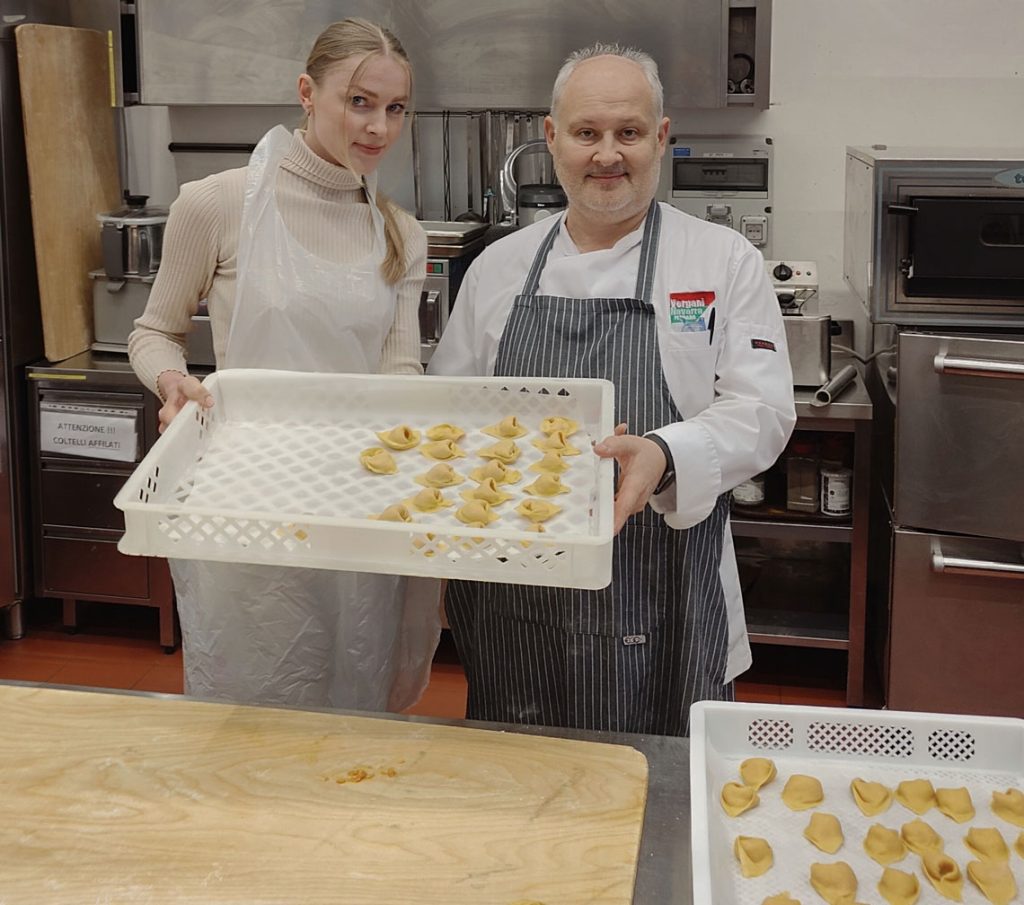
At the renowned Institute Vergani Navarra you can book an individual or a group cooking class to learn how to cook the typical specialties of Ferrara.
Never thought I could be able to cook such delicious dishes I just had at the restaurant. I experienced the preparation of cappellaci di zucca and “coppietta ferrarese” bread.
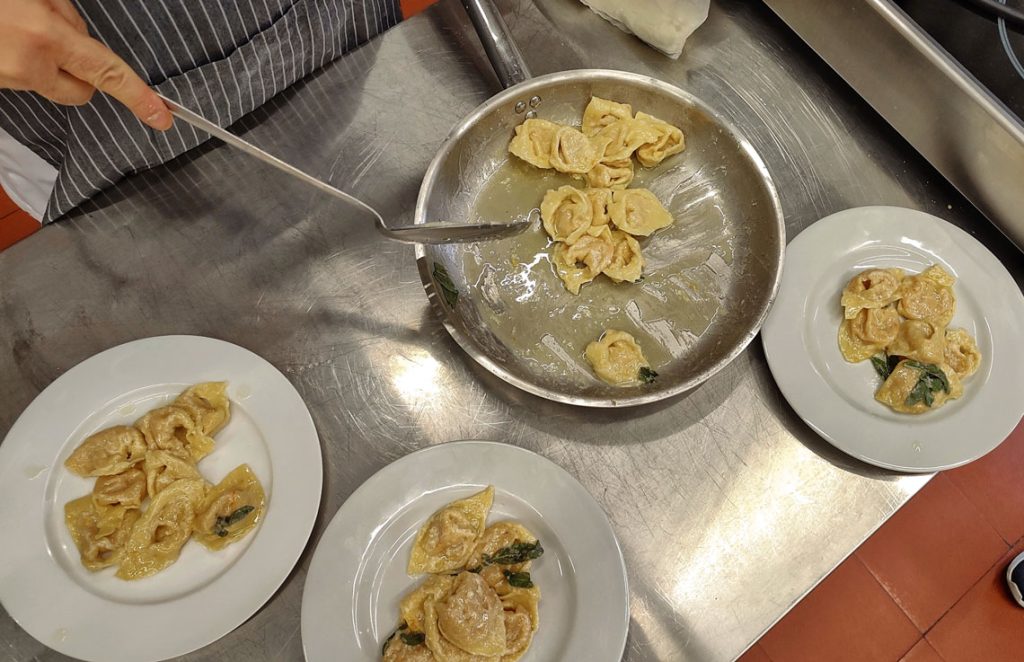
Starting from flour and eggs, gradually the pasta takes the characteristic shape of cappellacci. Some of the Chef’s tips were essential to the preparation of the pumpkin filling and of course to the success of the final dish.
What a pleasure then to digest the result, just like at the restaurant!
Book a cooking class
mail: booking.podeltatourism.it@feratel.tv
tel: +39 0532 419190
Outside Ferrara city
P.S.: If you want to discover another Ferrarese route, a few kilometers away from Ferrara the small Venice of Comacchio and Lidi Ferraresi await you, an ideal destination for excursions with 25 km of beaches and the nature of the delta of the river Po’.
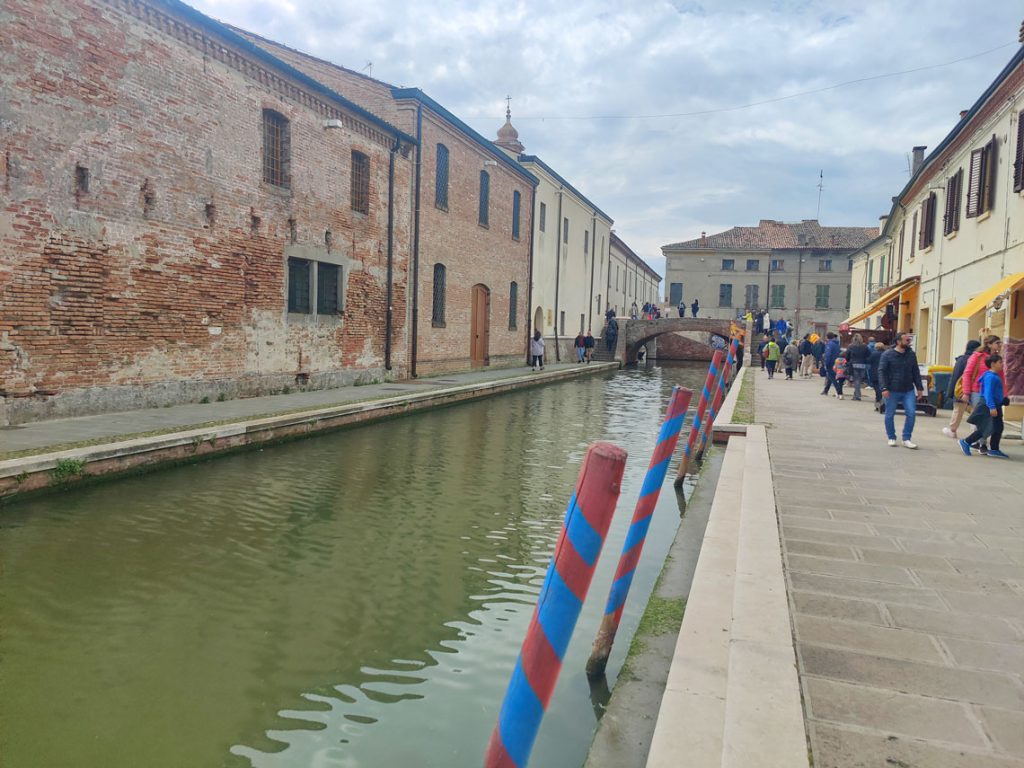
Have a good trip!








